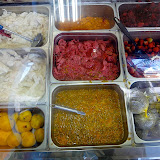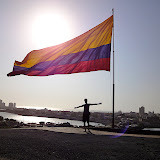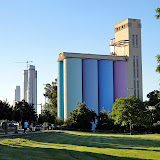Reconnecting with our buddy Martin meant heading to Juan's Hostel for more rooftop fun. Though we didn't realize it was a birthday party for two girls with at least 15 guests each. This presented a conundrum for giving saludos to everyone there. We obviously went to both the birthday girls, giving them a kiss hello and wishing them a happy birthday, but then merely waved to the rest and said our names, which I thought was sufficient. It appeared that we had made a grave faux pas in our Argentine greetings when the next guests that arrived went around the circle of more than 25 people, giving kisses hello and handshakes to everybody. The kiss hello is an unavoidable Argentine trend. Slightly ostracized from the main group for our lack of manners, Brent and I decided to head to one of Rosario's biggest clubs.
Taura was on the riverfront, right by the boatstation and the first club that I had been to in a month in Rosario. Clubs are becoming less and less my thing, but I could see how rolling there with a big crew of friends (the only way Argies roll) could be potentially awesome. Walking back however, we decided to cut through the park, trying to take a wide berth around a group of sleeping homeless people. It wasn't wide enough to deter their guard, which was a fairly big dog that rushed out barking at us. Before I even realized what happened, it lunged at me, trying to take a bite out of my leg, I instinctively kicked it square in the face with my boot; causing it to jump back and come back at us again, this time wagging it's tail and head held low. I raised my foot again and scolded it with verbal threats promising the next kick would ruin it's night, and it ran off.
Brent was a little more shocked than me of what had just transpired. "That was crazy! Did you get bit?" No no bites, and at the time, it didn't seem that big of a deal to me. When I had been living in the
barrio of La Plata, there were stray dogs everywhere, and though the majority of them have figured out it's easier to win more flies (or bones) with honey, some were a bit territorial. After talking to a couple friends, I was able to establish a couple rules for dealing with dogs in South America:
1.
Just mind your business, looking them in the eyes can be seen as an invitation or threat, so as long as you keep walking most will leave you alone
2.
Don't get startled or panic. Anytime I've ever been startled by a dog, it has returned the favor, getting more riled up, remember, they can smell your fear, literally.
3. If one does come at you for god's sake
DONT RUN! You think you can outrun a dog? They live for this stuff. Just do what I did,
stand your ground and yell at it. If it looks like it's coming at you,
hit it with a blunt object or kick it in the face. If you present yourself as more trouble than it's worth, the dog will leave you alone, showing it you have no fear is key.
Even if you do get bit, your chances of getting mauled are relatively low, but I hear that Rabies vaccine is 6 needles to the stomach three different times, so it's best to avoid both ; ).



















